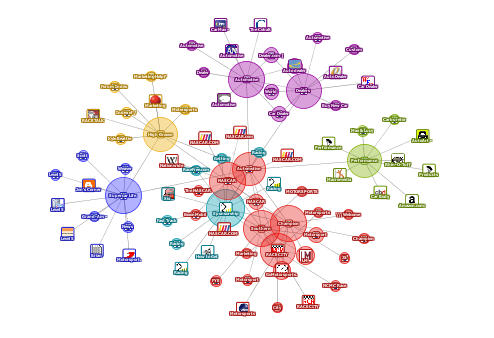There are several directories that you can also add your links to which will give you a certain amount of exposure. One of the easiest and most reasonably priced linking websites is Strongest Links (http://www.strongestlinks.com ) and offers a free 30-day trial period with full functionality. This website will give you an updated list of directories, the price they charge (if any) and how valuable the directory is as shown by various statistics.
____________________________________________________________
Tags: Web traffic, Website Traffic, SEO Authority, Web Optimization, link building, page rank
The Internet would not exist if it weren't for keywords. But the second most important element of the Internet involves linking of websites. Think of it -- its called the World Wide Web because all websites are connected to other sites in some way. One website leads to another which leads to another which leads to another.
There is a double-bind involved when you entertain linking to other websites. No one wants to send people away from their site by linking to another website. However, you wont get any links to your website if you dont create any links from your website to others. It is important that search engines see that your website is connected to the rest of the Internet by seeing links coming to your site from other locations.
Tags: Web traffic, Website Traffic, SEO Authority, Web Optimization, link building, page rank
Continuing the mantra, "It's all about keywords," once again, the focus for your PPC ad is relevant keywords. You are not limited to how many keywords you can target in your PPC ad campaigns. The keywords you choose will probably be chosen based on their cost. If you can target some 5-cent and 10-cent keywords, you can get more exposure for your budget. In contrast, if you target only high-priced keywords, you will usually be competing against deep-pocket competitors and your exposure will be limited.
By selecting several (10 or more) keywords and targeting ads for those keywords, you give yourself more opportunity to expose your website to a select audience. However, make sure that the keywords are not so obscure that you get too many non-productive click-throughs. It is a delicate balance and will take some testing to know what works and what doesn't. In addition, the broader or more general the keywords are, the more likely that the click-throughs will be non-productive. For example, if you target using the keyword, web design, your competition will be very high. If you use the keyword, web design Reno, you have a much higher chance of getting productive click-throughs. And the price will be lower.
Once you have determined which keywords you want to target, it's time to look at competitor's ads for these keywords. This is easy to do. Simply go to Google (http://adwords.google.com) or Yahoo (http://searchmarketing.yahoo.com) and enter the keyword or keyword phrase into the search block. When the results are displayed, pay attention to the ads that show up on the right-hand side of the page under Sponsored Links. Depending on the keyword, there are probably several pages of ads. Get a feel for the ad content, especially those that appear on the first page and in the top positions. Usually the higher the price an advertiser is willing to pay, the higher the position on the pages under sponsored links.
Remember that these links are hot and when you click on them, it will cost the advertiser the price of the click. Because you are not planning to purchase the advertiser's goods or services, don't click on their ad. Would you want to pay for a competitor's clicks? In fact, if you intentionally click on a competitor's ads with the idea of costing them advertising dollars, both Google and Yahoo would construe it as click fraud. Don't do what you wouldn't want done to you. If you want to go to their website, simply type in their URL to get to their site.
Once you have reviewed your competitors' ads, begin to formulate your ad. We will use Google AdWords for our example. Yahoo Search Marketing is very similar. There are five lines to complete for each ad. Devise your Google ad with the following points in mind:
- Headline: The first line allows a maximum of 25 characters. This line includes your keywords stated in a way that attracts the reader to read further. For example, using words such as free, easy, learn, how to and teach yourself are effective attractors. If your products are not free or you do not have a free offering, you can use attractors like cheap, discount, inexpensive, low cost or limited offer. The first line should be the attention grabber using keywords with attractors.
- Description lines: You have two description lines containing 35 characters each. Again, consider using additional keywords that support your heading or attract the viewer to your website. One of the ways you can attract viewers is to offer something specific. Perhaps it is a free report, a free download, or some other example of what you have to offer in your business or as an authority in the industry. Look back at your competitors' ads and get some ideas on the content for your ad. You don't want to copy their ad, but you may find it useful to borrow from it.
- Display URL: This is the computer URL link that you display to the viewer. If you have a domain name that is easily understood as a name or a phrase, you will want to make it very readable to the viewer. For example, do not use http://www.computergoddess.com/ but rather enter www.ComputerGoddess.com. It will be easier for your viewer to make the connection to your site, and this is a good step toward branding your name.
- Destination URL: This is the URL link that leads to your landing page, where you want the viewer to end up on your website. You may not necessarily want your viewer to land on your home page but rather on a sales page in direct response to your PPC offer.
- Split-testing: In order to find out which ads work well and which don't, create several ads for the same keyword or keyword phrase. Google and Yahoo offer a means of determining the number of click-throughs for each ad. The ads that get the highest click-throughs are the ads you want to keep. The ads with lower click-through rates should be modified or discarded.
Your homework this week is to study PPC ads of your competitors and devise several ads using targeted keywords. It is easy to set up ad campaigns and both Google and Yahoo Search Marketing do a good job of leading you through the process. Set up your ads; determine how much you are willing to spend each day on your ad campaign; and check back frequently to see how well your ad is pulling traffic.
Copyright © 2012 TAO Consultants, Inc. All rights reserved.
Reprinted with permission.
Your homework this week: Using a Google search for your main keywords and look at the ads that come up as a result under sponsored links. The ads coming up using those keywords are going to be your basic model for creating your own ads. Don't copy them directly, but try a couple of variations and split-test the results. Remember, as a courtesy, do NOT click on the ads that come up. If you want to see their website, then type their URL into the address box in your browser.
Tags: SEO | organic search | Paid Search, targetted Marketing, SEO, Website Traffic, Website Navigation
Editor's Note: This article will be first in a series of 14 reprinted articles on web optimization. To get the remaining articles, please sign up for this blog in the box at the left. The first (and maybe the second article) will be published by email. The rest, just through normal blog publishing.
Tags: Inbound Marketing, SEO, Website Traffic, Web Optimization, Keywords
As you review your website for the attention the search engines will give it and for its authority content, you need to determine if you have a clear call to action. A call to action on your website simply asks your viewer to do something. Are you asking the surfer to call you, to buy your product, to engage your services or simply to subscribe to your future communications? Think carefully about what you want next from your website visitors. This is your call to action (CTA). The purpose of a CTA is to create another contact point for your potential customer. It takes seven encounters on average before your prospect becomes a customer. If you don't ask or create a clear opportunity for your viewer to create a relationship with you and your business, you may not get your additional six contacts for the sale. Beyond the initial sale, you will want to set up an ongoing relationship with your customer. Business is not built on one sale, but on a continuous business relationship where you customer becomes a return purchaser. To build this loyalty, you must continue to place your name and image in front of your customer. Think of it this way: you spend most of your marketing efforts and dollars to get that first customer. When your customer returns for another purchase, you aren't spending much more in follow-up dollars. With techniques we are going to cover in future SEO SOS lessons, you will see that this cost is minimal and, therefore, yields the greatest return on your marketing dollar. Some examples of CTAs might be:
Tags: SEO, Website Traffic, Search Engine Optimatization, SERP, Website Navigation
- Provide relevant and substantial content. We have already discussed how content is King and keywords are the Queens. Just throwing keywords at a page without thoughtful content may get people to your site as a result of a keyword search; however, if your page visitor doesn’t find something of value at that website, they will leave as quickly as they came. And if they clicked on one of your Google AdWords ads, you have just paid for that useless visit with nothing to show for it.
- Google also suggests:
The page should contain information that is useful and accurate about the product or services searched. - If your landing page is not relevant to the keyword searched, it will be viewed as a waste of time and the viewer will flash away hoping to find what they want on someone else’s page.
- Provide information that is relevant and useful before you require them to subscribe or register. If the pre-register content has value, they will be eager to register to get more. Lay those crumbs out there clearly on the path to commitment to your site. After all, asking a viewer to register or subscribe isn’t really free. The price is their name and email address.
- Keep your ads, banners and affiliate links to a normal non-overloaded minimum. When a viewer arrives at a page filled with loads of ads and little content, off they scamper. You see, “It’s all about me,” the viewer says. The viewer isn’t arriving at your website with the intention of making you money, but to find answers to their questions or solutions to their problems. Don’t saturate them with ads.
- Your content must be unique. If your page mirrors 100 other web pages on the Internet, why would someone choose you over the others or ever consider you an authority? The importance of this non-mirrored content has to be handled delicately if you write and publish articles. [More on this topic in a later lesson.]
- Avoid misleading your visitors by providing exactly what you ad stated. No loss-leaders here. That tactic may work at a grocery store, but it can keep people from ever coming back to your website.
- Honor your deals and deliver as promised. In fact, the most successful businesses, either online or offline, make their offer, then over-deliver. Think in terms of delivering over and above what you offer and you will distinguish your business in the eyes of your customers. They will come back again and again. Remember, the first sale is not the business-building sale. It is the second, the third and fourth sales that make your business a success.
- Treat your customers well by protecting their information responsibly. Just as you would want your personal information managed correctly, so should you be able to insure that your privacy policy is clearly stated, and more importantly, clearly followed. Google’s guidelines seem to be reflective of common sense, yet too many web owners forget these details and send up either abusing or neglecting that ever-important component to their business: the customer.
Tags: targetted Marketing, Inbound Marketing, Website Traffic, Web Optimization, Elburn SEO







